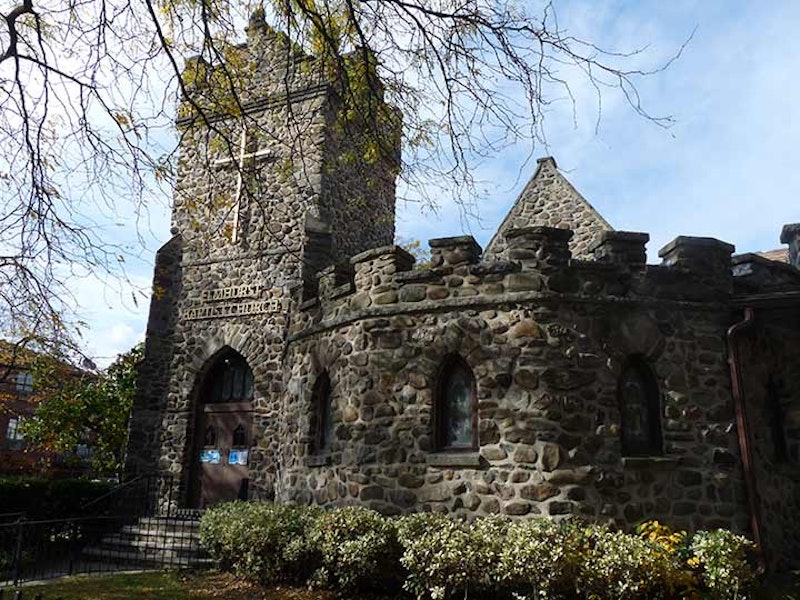Early British colonists in Maspeth were chased out by angry Native-Americans, and eventually moved further east, where Queens Blvd. meets Broadway today. Eventually, the name Newtown was applied to what was then a new town. By the mid-1800s, horse cars and eventually streetcars brought people from all over, and when Cord Meyer developed the area in the 1890s, he lobbied for a higher class name... Elmhurst. Strangely, the IND subway, which arrived in 1936, keeps the Newtown name at one station, and Newtown High School retains the old moniker, as do a pair of roads in Astoria that were formerly main thoroughfares leading to the town.
Whitney Ave. runs from Queens’ Broadway and meets the Long Island Railroad northeast to Roosevelt Ave. where the #7 elevated rumbles overhead. The core of Elmhurst has a checkerboard street grid laid out athwart the overall north-south grid found elsewhere in western Queens, and its streets are permitted to keep their names instead of the numbers found elsewhere in most of the borough. They were originally numbered but by 1915 they carried alphabetized names, from Aske through Macnish, which may commemorate early developers or investors. The avenues bear names like Whitney, Lamont, Britton and Baxter, again, likely homestead owners or developers, with Elmhurst Ave. thrown in. Whitney Ave. may or may not have anything to do with financier William C. Whitney (1841-1904), who built a mansion near Marine Park, Brooklyn and used his property to train and breed thoroughbred race horses. The New York Mets’ first owner, Joan Whitney Payson (1903-1975), was his granddaughter; the Whitney family’s tentacles can be spotted in Inwood, Manhattan and Sheepshead Bay, Brooklyn, so why not Elmhurst?
One of the jewels of Elmhurst is the cobblestone-exterior Elmhurst Baptist Church at Whitney and Judge. The cornerstone was laid in 1902, with the church completed the following year. There are Myanmar (Burmese) Baptist and Indonesian Baptist services offered here, as well as an Apostolic congregation worshiping in Spanish. The church was designed by the architect A. F. Leicht, with original plans calling for a stone building with an octagonal interior and a concave ceiling finished in hardwoods with a seating capacity of 500.

A short distance away on Whitney, this brick building supports a Chinese-dominated congregation with services in English and Mandarin. The building may have originally been a synagogue, as the word Mizpah (Watchtower) formerly appeared above the front door, but there are equal chances a Protestant congregation met here.

A block away on Ithaca St. and Whitney is Elmhurst’s biggest Catholic church, St. Bartholomew’s, which isn’t quite as famed as its Park Avenue namesake. The large Italinate church was built in the 1930s (as with many churches, online information is sketchy; still, this is a magnificent building and you’d hope for better building records to be readily available). The parish was established in 1906 and the original church is still standing, midblock on Ithaca between Whitney and 43rd Aves.

A walk down Ithaca between Whitney and 43rd Ave. reveals the old St. Bartholomew Church, built in 1910 (the cornerstones show the founding date of the parish, as well as the completion date). Ithaca St. was still 4th St. when the church opened in 1911. The building is now called Heafy Hall, after original pastor Jeremiah Heafy (the sign on the building misspells it as Heafey). Note the delicately-worked sandstone; according to the article the stained glass windows were imported from Munich.
St. Bartholomew, one of the original 12 Apostles, is the least known — there are no Bible stories associated with him and he isn’t quoted at all—though he was an associate of a fellow Apostle, St. Philip. Any stories about him come from apocrypha and Christian tradition. According to that, he was martyred for converting an Armenian king, and was skinned alive and then beheaded. Consequently, many depictions of him in statuary show him holding a flaying knife.

Also on Ithaca St. is the Jain Center of Elmhurst. From builder SEN Architects: Jain Center at Elmhurst is a four-storied structure, with two religious temples, a meeting hall, library, meditation rooms, exhibition halls and classrooms for youth centered activities. It serves the social and religious requirements of the Jain community in Queens. Jainism is an ancient faith, originating in India in the 6th Century Before Common Era as an offshoot of Hinduism. The Jain religion teaches salvation by perfection through successive lives and non-injury to living creatures, and is noted for its ascetics. Buffy Sainte-Marie mentions it in her song “Universal Soldier.”
—Kevin Walsh is the webmaster of the award-winning website Forgotten NY, and the author of the books Forgotten New York (HarperCollins, 2006) and also, with the Greater Astoria Historical Society, Forgotten Queens (Arcadia, 2013)

